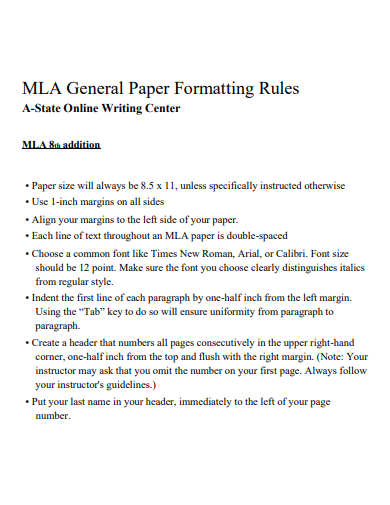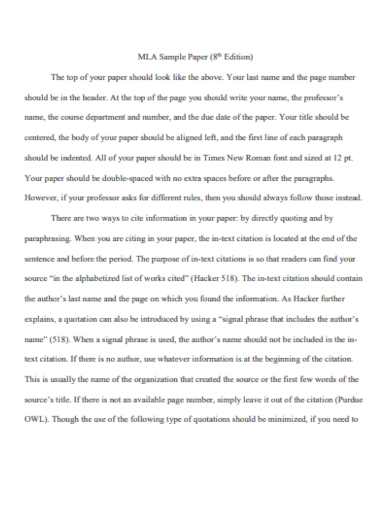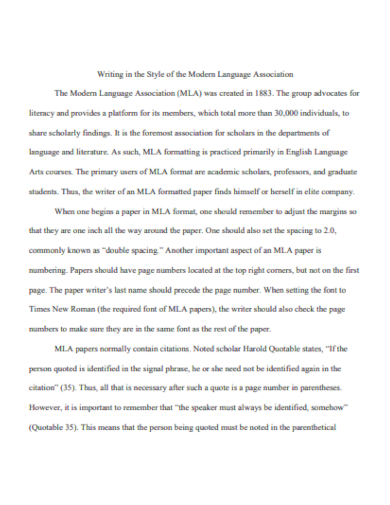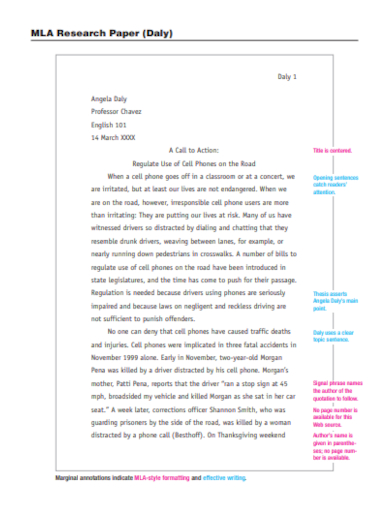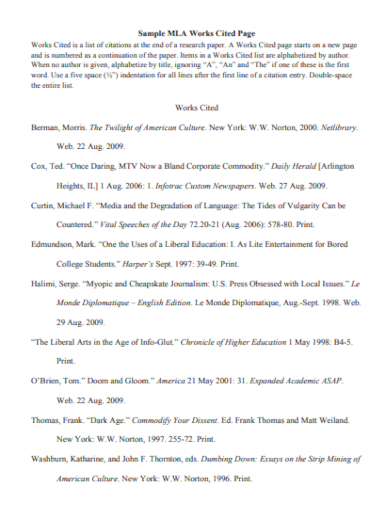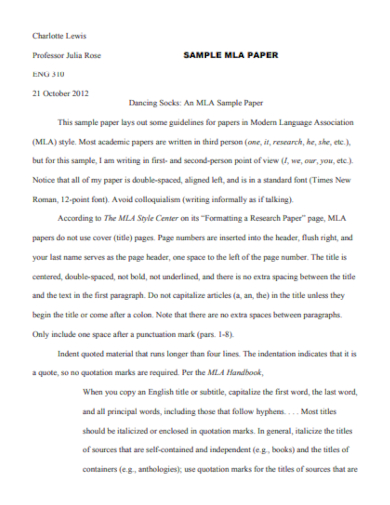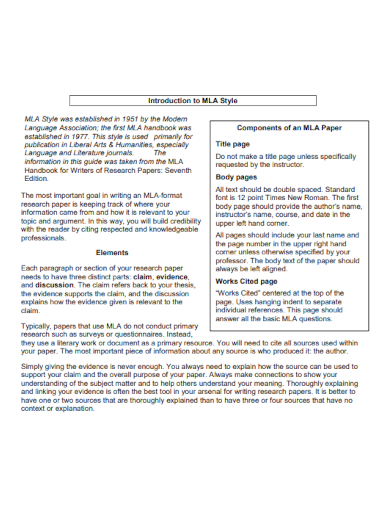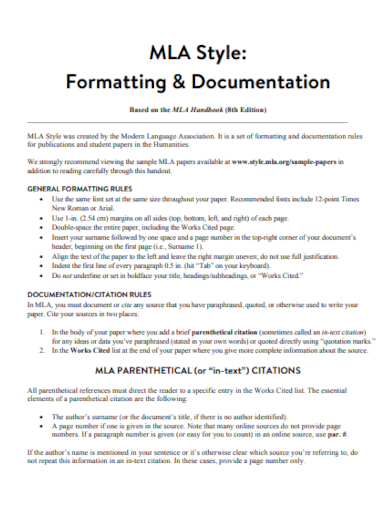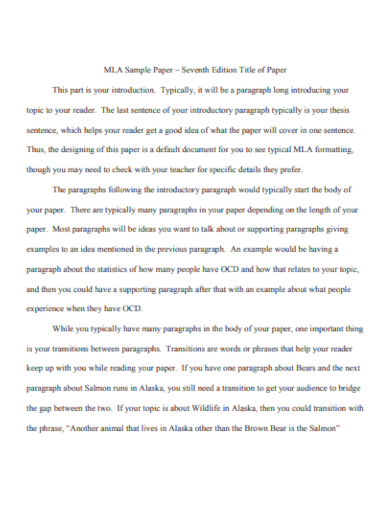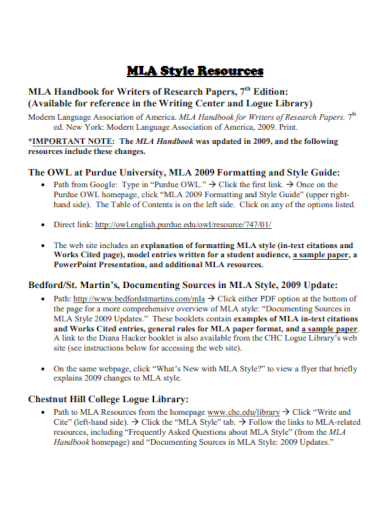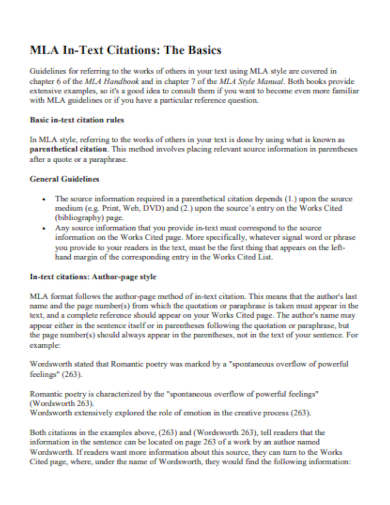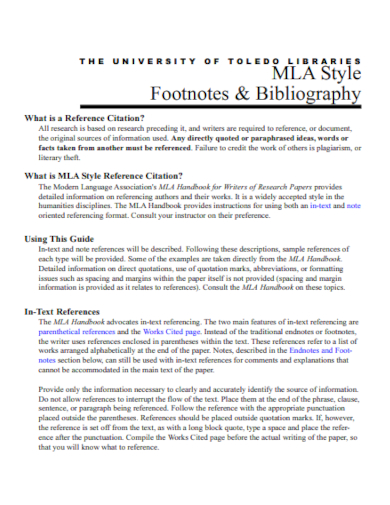Research papers as well as academic or student papers can be written using different formats in various styles which also have their own specific requirements and guidelines. Some of the common formats utilized in academic writing are the MLA format, APA format, Chicago style, Harvard, IEEE, Vancouver, and AMA format. Every one of these formats has specific guidelines for citing sources, formatting headings, page layout, and writing reference lists which makes it an important factor to determine the formatting style required by your publisher or academic institution.
15+ MLA Paper Samples
1. MLA General Paper Format
2. MLA Sample Paper
3. Formatting MLA Sample Paper
4. MLA Style Sample Paper
5. MLA Research Sample Paper
6. Sample Outline for MLA Paper
7. College MLA Sample Paper
8. MLA Works Cited Page Sample Paper
9. Paragraph MLA Sample Paper
10. MLA Title Sample Paper
11. General MLA Sample Paper
12. MLA Sample Paper Documentation
13. 7th Edition MLA Sample Paper
14. MLA Style Reference Paper
15. MLA In-Text Citation Paper
16. Bibliography MLA Sample Paper
What is an MLA Paper?
MLA papers are research papers or academic essays that comply with the formatting rules and guidelines set and established by the Modern Language Association or MLA. This style is commonly used in fields of study in humanities like literature, language, cultural studies, and history. The MLA style is continuously updating, making it important to regularly check the latest edition of the MLA Handbook or visit the official MLA website for the latest changes in its guidelines. The MLA format is commonly used for documents such as essay structures, research papers, literary analyses, book reviews, literary critiques, annotated bibliographies, and short stories and poems.
How to Write an MLA Paper
An MLA paper aims to provide a well-structured, properly cited, and organized analysis or research on relevant topics on language, cultural studies, literature, and history. With the MLA formatting style, authors are provided with consistent and uniform papers which also enables the readers to easily navigate and validate the sources cited to maintain scholarly integrity and credibility.
Step 1: Make Sure That You Understand the MLA Guidelines
Before you start writing, make sure that are familiar with the MLA rules and guidelines by reviewing the MLA Handbook or visiting the official MLA website. This will help you understand the style’s formatting rules, in-text citation requirements, and the proper construction of the Works Cited page.
Step 2: Create the Outline of Your Content
Create the paper’s content outline, including a clear introduction, body paragraphs, and a conclusion while making sure that your arguments or points are flowing in a logical manner and support your thesis statement. You can utilize headings and subheadings for each section to organize its content more effectively.
Step 3: Utilize In-Text Citations
Use parenthetical in-text citations when you reference the sources in your MLA paper. This includes the author’s last name and the page number of the cited data in parentheses at the end of the sentence. You can use quotation marks around the text for direct quotations while you can provide the author’s last name and page number without quotation marks.
Step 4: Include a Works Cited Page
As you conclude your MLA paper, make sure to include a Works Cited page to list down all the sources you used in the paper. Arrange them alphabetically by the author’s last name, include important publication information, and pay attention to the formatting of every entry.
FAQs
What is the basic format of an MLA paper?
The basic format of an MLA paper includes elements such as the page setup, header, title, heading and subheadings, text, in-text citations, and Works Cited page.
What are the advantages of using the MLA format?
With the MLA format, writers and readers are provided with clarity and consistency, proper attribution of sources, reader-friendly format, scholarly credibility, universal style, efficient documentation, and focus on content.
What are the common situations where the MLA format is used?
MLA formats are commonly used for college applications or university assignments, research papers, academic essays, and literature reviews. However, it is important to confirm with your instructor the assignment requirements to make sure that the MLA format is the appropriate style to use for a specific writing assignment.
Set forth by the Modern Language Association, the MLA format is a list of guidelines that are implemented and followed when writing and formatting academic papers, especially in the fields of humanities. The MLA paper refers to the academic document that follows these guidelines, including specific rules for the paper’s page setup, headers, titles, headings and subheadings, in-text citations, and a Works Cited page.
Related Posts
FREE 10+ Research Essay Outline Samples in PDF MS Word ...
FREE 9+ Essay Outline Samples in MS Word PDF
FREE 8+ Sample Research Paper Outline Templates in PDF
FREE 8+ Essay Samples in MS Word PDF
FREE 20+ Research Paper Outlines in PDF MS Word
FREE 10+ Informative Speech Thesis Statement Samples [ Paper ...
FREE 6+ Sample Research Papers in PDF
FREE 19+ Sample Reflective Essay Templates in MS Word PDF
FREE 5+ Paper Outline Samples in PDF MS Word
FREE 6+ Sample of APA Paper Templates in MS Word PDF
FREE 6+ Sample Research Paper Outline Templates in PDF MS ...
FREE 10+ Informative Thesis Statement Samples [ Speech, Paper ...
FREE 8+ School Essay Samples in MS Word PDF
FREE 10+ Writing Outline Samples in PDF
FREE 8+ Persuasive Essay Samples in MS Word PDF

